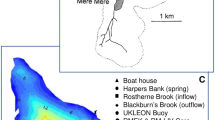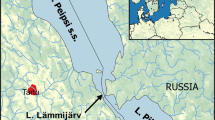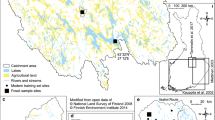Abstract
Sustainable lake management for nutrient-enriched lakes must be underpinned by an understanding of both the functioning of the lake, and the origins of changes in nutrient loading from the catchment. To date, limnologists have tended to focus on studying the impact of nutrient enrichment on the lake biota, and the dynamics of nutrient cycling between the water column, biota and sediments within the lake. Relatively less attention has been paid to understanding the specific origins of nutrient loading from the catchment and nutrient transport pathways linking the lake to its catchment. As such, when devising catchment management strategies to reduce nutrient loading on enriched lakes, assumptions have been made regarding the relative significance of non-point versus point sources in the catchment. These are not always supported by research conducted on catchment nutrient dynamics in other fields of freshwater science. Studies on nutrient enrichment in lakes need to take account of the history of catchment use and management specific to each lake in order to devise targeted and sustainable management strategies to reduce nutrient loading to enriched lakes. Here a modelling approach which allows quantification of the relative contribution of nutrients from each specific point and non-point catchment source over the course of catchment history is presented. The approach has been applied to three contrasting catchments in the U.K. for the period 1931 to present. These are the catchment of Slapton Ley in south Devon, the River Esk in Cumbria and the Deben Estuary in Suffolk. Each catchment showed marked variations in the nature and intensity of land use and management. The model output quantifies the relative importance of point source versus non-point livestock and land use sources in each of the catchments, and demonstrates the necessity for an understanding of site-specific catchment history in devising suitable management strategies for the reduction of nutrient loading on enriched lakes.
Similar content being viewed by others
References
Anderson, N. J., B. Rippey & C. E. Gibson, 1993. A comparison of sedimentary and diatom-inferred phosphorus profiles: implication for defining pre-disturbance nutrient conditions. Hydrobiologia 253: 357–366.
Bennion, H., 1994. A diatom-phosphorus transfer function for shallow, eutrophic ponds in southeast England. Hydrobiologia 275/276: 391–410.
Bennion, H., S. Wunsam & R. Schmidt, 1995. The validation of diatom-phosphorus transfer functions: an example from Mondsee, Austria. Freshwat. Biol. 34: 271–283.
Bailey-Watts, A. E. & A. Kirika, 1987. A re-assessment of the phosphorus inputs to Loch Leven (Kinross, Scotland): rationale and an overview of results in instantaneous loadings with special reference to run-off. Trans. r. Soc. Edin. Earth Sciences 78: 351–367.
Bailey-Watts, A. E., A. Kirika, L. May & D. H. Jones, 1990. Changes in phytoplankton over various time scales in a shallow, eutrophic lake: the Loch Leven experience with special reference to the influence of flushing rate. Freshwat. Biol. 23: 85–111.
Dils, R. M. & A. L. Heathwaite, 1996. Phosphorus transport in agricultural runoff, In S. Brooks & M. Anderson (eds), Advances in Hillslope Processes, Wiley, Chichester.
Driscoll, C. T. & R. Van Dreason, 1993. Seasonal and long-term temporal patterns in the chemistry of Adirondack lakes. Wat. Air Soil Pollut. 67: 319–344.
Duffy, P. D., J. D. Schreiber, D. C. McClurkin & L. L. McDowell, 1978. Aqueous-and sediment-phase phosphorus yields from five southern pine watersheds. J. Envir. Qual. 7: 45–50.
Edmondson, W. T., 1970. Phosphorus, nitrogen and algae in Lake Washington after diversion of sewage. Science 169: 690–691.
Edmondson, W. T., 1985. Recovery of Lake Washington from eutrophication, In Proceedings of the International Congress on Lake Pollution and Recovery, European Water Pollution Control Association, Rome, April 15–18: 228–234.
Edmondson, W. T. & J. T. Lehman, 1981. The effect of changes in the nutrient income on the condition of Lake Washington, Limnol. Oceanogr. 26: 1–29.
Foster, I. D. L., P. N. Owens & D. E. Walling, 1996. Sediment yields and sediment delivery in the catchments of Slapton Lower Ley, South Devon, U.K. Field Studies 8: 629–661.
Foy, R. H., Smith, R. V., Stevens, R. J. & D. A. Stewart, 1982. Identification of factors affecting nitrogen and phosphorus loadings to Lough Neagh. J. Environmental Management 15: 109–129.
George, D. G., D. P. Hewitt, J. G. W. Lund & W. J. P. Smyly, 1990. The relative effects of enrichment and climate change on the long-term dynamics of Daphnia in Esthwaite Water, Cumbria. Freshwat. Biol. 23: 55–70.
Heathwaite, A. L. & P. J. Johnes, 1996. The contribution of nitrogen species and phosphorus fractions to stream water quality in agricultural catchments. Hydrological Processes 10: 971–983.
Heathwaite, A. L., P. J. Johnes & N. E. Peters, 1996. Trends in water quality 6: trends in nutrients, Hydrological Processes 10: 263–293.
Heckrath, G., P. C. Brooks, P. R. Poulton & K. W. T. Goulding, 1996. Phosphorus losses in drainage waters from arable silty clay loam soil. In H. Tunney & O. Caton (eds), Phosphorus Loss to Water from Agriculture. C.A.B. International: 367–9.
Holden, A. V. & L. A. Caines, 1974. Nutrient chemistry of Loch Leven, Kinross. Proc. Royal. Society Edin. B 74: 101–122.
Johnes, P. J., 1994. Modelling nutrient loading on the Ore/Alde and Deben estuaries, 1930-1990. Unpublished report for National Rivers Authority, Anglian Region, Peterborough.
Johnes, P. J., 1996a. Nutrient export to the River Bure from its catchment, 1930–1995. Unpublished report for the Environment Agency, Anglian Region, Ipswich.
Johnes, P. J., 1996b. Evaluation and management of the impact of land use change on the nitrogen and phosphorus load delivered to surface waters: the export coefficient modelling approach. Journal of Hydrology 183: 323–349.
Johnes, P. J. & T. P. Burt, 1991. Water quality trends in theWindrush catchment: nitrogen speciation and sediment interactions. In N. E. Peters & D. E. Walling (eds), Sediment and Stream Water Quality in a Changing Environment: Trends and Explanation. IAHS Publication 203, Wallingford 349–357.
Johnes, P. J. & T. P. Burt, 1993. Nitrate in surface waters. In T. P. Burt, A. L. Heathwaite & S. T. Trudgill (eds), Nitrate: Processes, Patterns and Control. John Wiley, Chichester: 269–320.
Johnes, P. J. & A. L. Heathwaite, 1997. Modelling the impact of land use change on water quality in agricultural catchments. Hydrological Processes 11: 269–286.
Johnes, P. J., B. Moss & G. L. Phillips, 1996. The determination of water quality by land use, livestock numbers and population date – testing of a model for use in conservation and water quality management, Freshwat. Biol. 36: 451–473.
Johnes, P. J. & H. M. Wilson, 1996. The limnology of Slapton Ley. Field Studies 8: 585–612.
Knuuttila, S., O-P. Pietiläinen & L. Kauppi, 1994. Nutrient balances and phytoplankton dynamics in two agriculturally loaded shallow lakes. Hydrobiologia 275/276: 359–369.
Lund, J. W. G., 1972. Changes in the biomass of blue-green and other algae in an English lake from 1945-69. In T. V. Desikachary (ed.), Taxonomy and Biology of Blue-Green Algae, Madras Symposium, 1970: 305–327.
Meteorological Office, 1989. Climatological Data for Agricultural Land Classification. The Meteorological Office, Bracknell.
Meteorological Office, 1992. MORECS – the Meteorological Office Rainfall and Evaporation Calculation System database. The Meteorological Office, Bracknell.
Moss, B., H. Balls, I. Booker, K. Manson & M. Timms, 1988. Problems in the construction of a nutrient budget for the River Bure and its Broads (Norfolk) prior to its restoration from eutrophication. In F. E. Round (ed.), Algae and The Aquatic Environment Biopress Ltd., Bristol: 326–353.
Moss, B., P. J. Johnes & G. L. Phillips, 1996. The monitoring of ecological quality and the classification of standing waters in temperate regions: a review and proposal based on a worked scheme for British waters. Biol. Rev. 71: 301–339.
O'Sullivan, P. E., 1994. The Natural History of Slapton Ley National Nature Reserve XXI: the palaeolimnology of the uppermost sediments of the Lower Ley, with interpretations based on 210Pb dating the historical record. Field Studies 8: 403–449.
Phillips, G. L., R. Jackson, C. Bennett & A. Chilvers, 1994. The importance of sediment phosphorus release in the restoration of very shallow lakes (The Norfolk Broads, England) and implications for biomanipulation. Hydrobiologia 275/276: 445–456.
Ryding, S-O. & C. Forsberg, 1979. Nitrogen, phosphorus and organic matter in running waters: studies from six drainage basins. Vatten 1: 46–58.
Sharpley, A. N., 1996. Identification of critical source areas for phosphorus export from agricultural catchments. In S. Brooks & M. Anderson (eds), Advances in Hillslope Processes, Wiley, Chichester.
Sharpley, A. N. & J. K. Syers, 1976. Phosphorus transport in surface runoff as influenced by fertiliser and grazing cattle. New Zealand Journal of Science 19: 277–282.
Stevens, R. J. & B. M. Stewart, 1982. Concentration, fractionation and characterisation of soluble organic phosphorus in river water entering Lough Neagh. Wat. Res. 16: 1507–1519.
Stoddard, J. L., 1994. Long-term changes in watershed retention of nitrogen, In L. A. Baker (ed.), Environmental Chemistry of Lakes and Reservoirs. Advances in Chemistry Series 237, American Chemical Society, Washington, D.C.
Talling, J. F. & S. I. Heaney, 1988. Long term changes in some English (Cumbrian) lakes subjected to increased nutrient inputs, In F. E. Round (ed.), Algae and the Aquatic Environment, Biopress, Bristol 1–29.
Withers, P. J. A., 1994. The significance of agriculture as a source of phosphorus pollution to inland and coastal waters in the U.K. Unpublished report to MAFF, London, 90 pp.
Author information
Authors and Affiliations
Rights and permissions
About this article
Cite this article
Johnes, P.J. Understanding lake and catchment history as a tool for integrated lake management. Hydrobiologia 395, 41–60 (1999). https://doi.org/10.1023/A:1017002914903
Issue Date:
DOI: https://doi.org/10.1023/A:1017002914903




